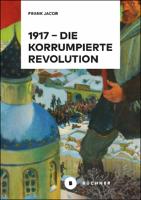1917 – Die korrumpierte Revolution
| dc.contributor.author | Jacob, Frank | |
| dc.date.accessioned | 2022-02-18T15:02:50Z | |
| dc.date.available | 2022-02-18T15:02:50Z | |
| dc.date.issued | 2020 | |
| dc.identifier | ONIX_20220218_9783963177231_23 | |
| dc.identifier | OCN: 1202452321 | |
| dc.identifier.uri | https://library.oapen.org/handle/20.500.12657/52963 | |
| dc.description.abstract | The Russian Revolution of 1917, which in reality consisted of several uprisings, forms the caesura between the »long« 19th and the »short« 20th century and ushered in the so-called »Age of Extremes« (Eric Hobsbawm). Many who had believed in the success of the revolution were bitterly disappointed by the actual developments. Once again, a revolution had not been able to achieve what many had expected, even longed for. The revolutionary uprising of February 1917 ended with its corruption in October of the same year. On the basis of an analytical comparative model, Frank Jacob addresses the question of the process of this corruption and shows whether it was due to an inevitable development of events or rather to the will to power of a few. | |
| dc.language | German | |
| dc.subject.classification | thema EDItEUR::N History and Archaeology::NH History::NHT History: specific events and topics::NHTV Revolutions, uprisings, rebellions | en_US |
| dc.subject.classification | thema EDItEUR::1 Place qualifiers::1D Europe::1DT Eastern Europe::1DTA Russia | en_US |
| dc.subject.classification | thema EDItEUR::3 Time period qualifiers::3M c 1500 onwards to present day::3MP 20th century, c 1900 to c 1999::3MPB Early 20th century c 1900 to c 1950::3MPBF c 1910 to c 1919::3MPBF-RU-R 1917–1923 (Russian Revolutionary period) | en_US |
| dc.subject.classification | thema EDItEUR::N History and Archaeology | en_US |
| dc.subject.classification | thema EDItEUR::3 Time period qualifiers::3M c 1500 onwards to present day::3MP 20th century, c 1900 to c 1999 | en_US |
| dc.subject.classification | thema EDItEUR::J Society and Social Sciences::JP Politics and government::JPF Political ideologies and movements::JPFC Far-left political ideologies and movements | en_US |
| dc.subject.other | Bolshevism | |
| dc.subject.other | February Revolution | |
| dc.subject.other | October Revolution | |
| dc.subject.other | Russian Revolution | |
| dc.subject.other | Eric Hobsbawm | |
| dc.subject.other | Russian Empire | |
| dc.subject.other | civil war | |
| dc.subject.other | Soviets | |
| dc.subject.other | Reinhart Koselleck | |
| dc.subject.other | socialism | |
| dc.subject.other | Petrograd | |
| dc.subject.other | Russia | |
| dc.subject.other | communism | |
| dc.subject.other | global power | |
| dc.subject.other | proletariat | |
| dc.subject.other | Lenin | |
| dc.subject.other | Soviet Union | |
| dc.title | 1917 – Die korrumpierte Revolution | |
| dc.type | book | |
| oapen.abstract.otherlanguage | Die Russische Revolution von 1917, die in Wirklichkeit aus mehreren Erhebungen bestand, bildet die Zäsur zwischen »langem« 19. und »kurzem« 20. Jahrhundert und leitete das sogenannte »Zeitalter der Extreme« (Eric Hobsbawm) ein. Viele, die an den Erfolg der Revolution geglaubt hatten, wurden von den tatsächlichen Entwicklungen bitter enttäuscht. Wieder einmal war eine Revolution nicht dazu in der Lage gewesen, das zu erreichen, was von vielen erwartet, ja herbeigesehnt wurde. Die revolutionäre Erhebung des Februar 1917 endete mit ihrer Korrumpierung im Oktober desselben Jahres. Frank Jacob widmet sich auf Basis eines analytischen Vergleichsmodells der Frage nach dem Prozess dieser Korrumpierung und zeigt, ob diese einer zwangsläufigen Entwicklung der Ereignisse oder vielmehr dem Machtwillen einiger weniger geschuldet war. | |
| oapen.identifier.doi | 10.14631/978-3-96317-723-1 | |
| oapen.relation.isPublishedBy | 1693c2dd-7cd7-4dac-b4bb-0dec0525ad05 | |
| oapen.relation.isbn | 9783963177231 | |
| oapen.relation.isbn | 9783963172007 | |
| oapen.pages | 244 | |
| oapen.place.publication | Marburg |

